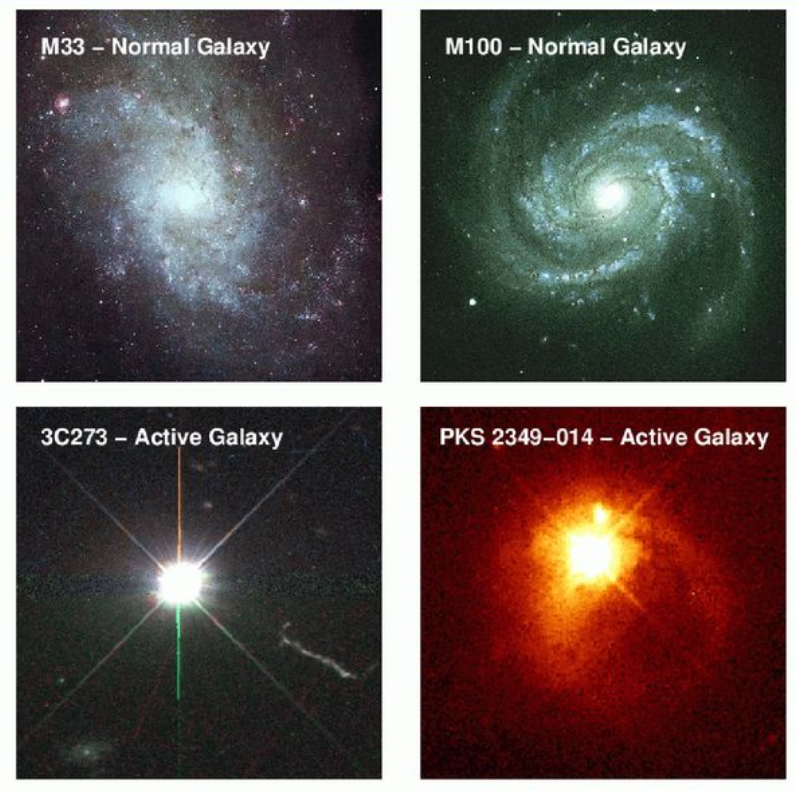The massive galaxies and a fraction of lower mass galaxies in the Local Universe host a super massive black hole (SMBH) in their center. They have masses between millions to 10 billions times the mass of the Sun. When matter from the galaxies starts to fall into the SMBH in the center of the galaxy, an enormous amount of energy is released across the electromagnetic spectrum (from radio emission up to X- and γ-rays). These galaxies, then, are called active galaxies and these phenomena are also well-known as Active Galactic Nuclei (AGN). Our Milky Way galaxy has one of these supermassive black holes at its center, but our galaxy is not an active one. Active galaxies require that gas and dust are in the act of falling into the black hole and glowing brightly on the way in. The Milky Way isn’t currently doing this and when material isn’t falling into the black hole, it simply sits. We don’t see the area right around the black hole in the center of our galaxy because there isn’t any glowing material so there’s nothing that we can see (this is the case with other galaxies that are not “active” as well). So we study the active galactic nuclei of other galaxies where the central supermassive black hole is busy consuming the gas and dust around it.
The main components of an AGN is the SMBH in the center of the galaxy, a hot corona, an accretion disc that surrounds the SMBH and in some cases (~10% of the whole AGN population) relativistic jets with sizes of 10 light-days up to 30 millions light-years (1 light-year is the distance that light travels in one year and is about 9.5 trillion km!). Besides these, there are also two regions of gaseous clouds with different properties. The first one is called Broad Line Region (BLR) and it is very close to the SMBH (a few up to hundreds light days). This gas moves around the black hole with speed higher than thousand km/s, while it has temperature of 10 thousand K. The second region is called Narrow Line region (NLR). NLR is a gaseous region much further than the BLR with size of 10 thousands to a million light-days and consists of clouds that move between 200 and 1000 km/s. Finally, there is a thick torus of dust that might hide the central engine including BLR.

In many cases, the power and of a single AGN with a size that is similar to our Solar System is much higher than the power emitted by the entire stellar population of its host galaxy and its luminosity may overshadow the light emitted by the galaxy. In the images above, examples of normal and active galaxies are shown, where the light emitted from the super-massive black hole in active galaxies is way higher than this of normal galaxies. For normal galaxies, we think of the total energy they emit as the sum of the emission from each of the stars found in the galaxy, but in active galaxies, this is not true. There is a great deal more emitted energy in active galaxies than there should be and this excess energy is found in the infrared, radio, UV, and X-ray regions of the electromagnetic spectrum. Furthermore, the cores of active galaxies are typically highly variable in all wavelenghts, because many explosive and obscuring processes occur in an AGN.

Thus, active galaxies are intensely studied at all wavelengths. Since they can change their behavior on short timescales, it is useful to study them simultaneously at all energies. X-ray and gamma-ray observations have proven to be important parts of this multi-wavelength approach since many high-energy quasars (the brightest AGN) emit a large fraction of their power at such energies. The X-rays in AGN originate from very near the black hole, so X-ray studies can provide scientists with unique insights into the physical processes occurring in the central engine. In addition, gamma-ray observations alone can provide valuable information on the nature of particle acceleration in the quasar jet and clues as to how the particles interact with their surroundings.
